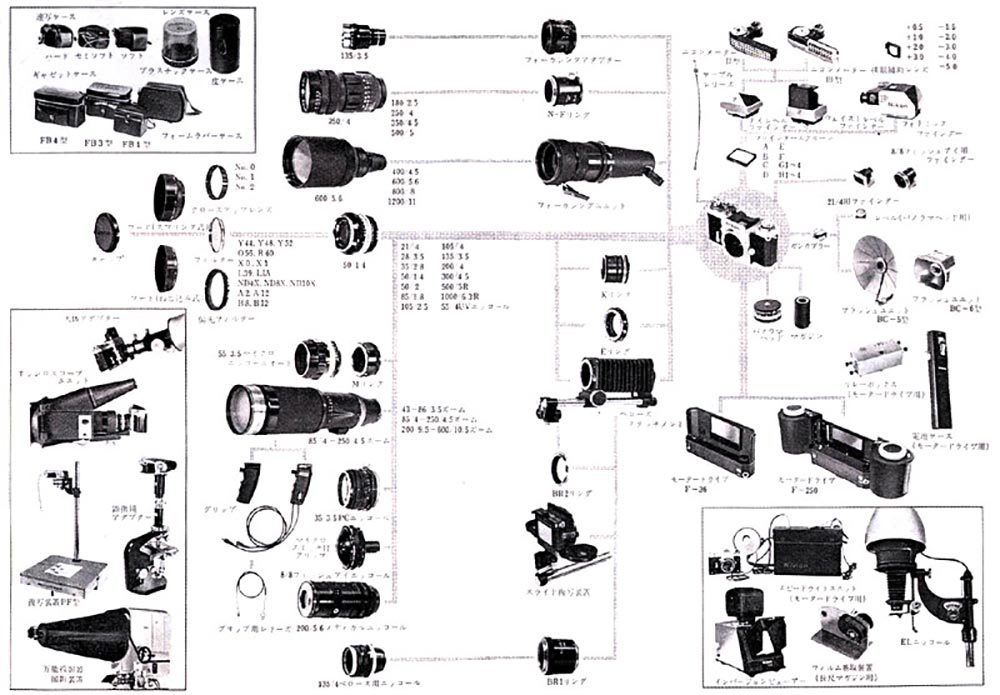Debut of Nikon F
- Design philosophy of single-lens reflex camera Nikon F system
- Introduction of Nikon F on the market and expansion of F system
- Nikkor lenses supporting the system
- Expanding our market
- Tokyo Olympic Games and Nikon
- Increasing sales of SLR camera Nikomat and interchangeable lenses
Design philosophy of single-lens reflex camera Nikon F system
Limitations of rangefinder camera and evolution into single-lens reflex camera
The 35 mm (135) format rangefinder focal-plane shutter cameras, typified by our Nikon SP (1957) and S3 (1958), featured sophisticated design and greater portability, and nearly reached perfection in terms of mechanism. Especially when combined with standard or wide-angle lenses, they offered the most advantageous features.
However, for combined use with any telephoto lens with a focal length of 135 mm or more, the optional reflex box had to be added rather than using a rangefinder integrated in the body. As a result, telephoto lens models increased, and the 35-mm single-lens reflex cameras (hereafter called SLR cameras) stood out as having the advantages of the reflex box integrated in the cameras.
The 35 mm SLR cameras date back to the Kine-Exakta manufactured and marketed in 1936 by the Ihagee Kamerawerk, Steenbergen & Co. in Germany. The viewfinder on the camera was a waist-level finder providing an inverted image. In addition, the reflex mirror was not of the automatic return type, and once the shutter was pressed the viewfinder remained inactive until the shutter became charged again, which was a drawback because it made it difficult to take a snapshot.
After the Second World War, the camera was equipped with the pentaprism type eye-level (erect image) viewfinder, full-automatic aperture control, quick-return reflex mirror and other enhancements, and the drawbacks of SLR cameras were removed and ease of operation was improved.
We at Nikon also recognized the future potential of SLR cameras in view of the fact that the telephoto lenses with a focal length of 135 mm or more would need a reflex box, and decided in fact around 1955 to launch a program for the development of SLR cameras in conjunction with the development of SP and S3, as the successors to Nikon S2 (1954), and their improved versions.
However, around 1955, the predominant view was that SLR cameras provided advantages not available with rangefinder cameras, although they could not be superior high-performance equipment. Nikon also favored that view because S2, Nikon SP and other popular models were so great. Then, in the development of SLR cameras, we planned to adopt the same body mechanism as in the SP/S3 as a rule (without any change made to the layout and geometry of the shutter button, film wind-up lever and other components), except for the viewfinder and other parts essential for SLR cameras, with the intent to implement parallel production with SP and the basic model S3.
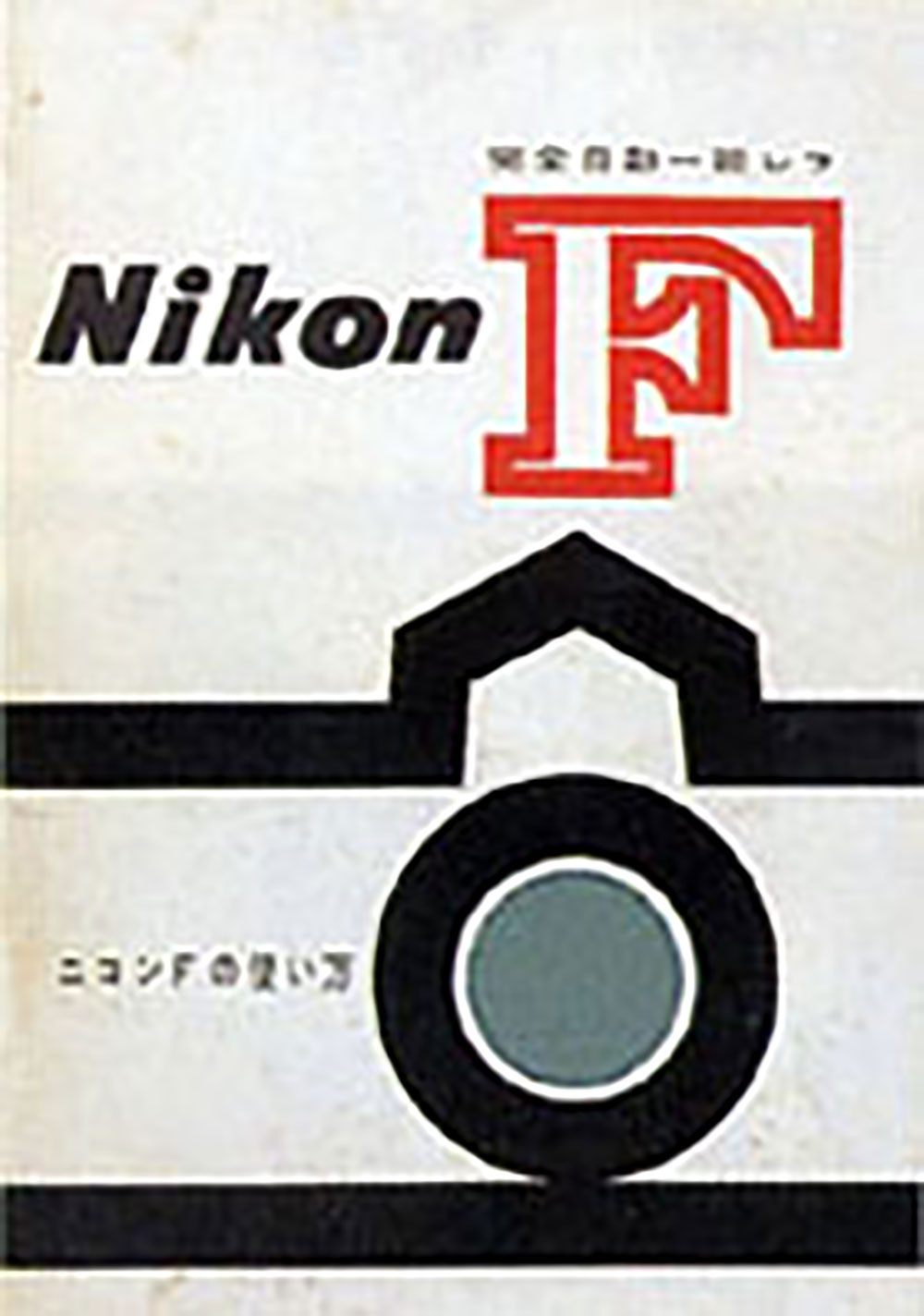
Nikon's SLR cameras were designed based on the philosophy and specifications described below.
- 1.We aimed at quick-response, easy-to-use cameras comparable to rangefinder cameras with the emphasis placed on automated operation while the SLR cameras were mostly bulky and heavy due to the integrated pentaprism, mirror box and other component parts.
- 2.We intended to offer system cameras which could accommodate various photographic purposes by producing a camera body with the highest possible performance to fully provide the features of SLR cameras, and by making available a wide variety of interchangeable lenses and accessories.
The required interchangeable lenses and accessories were made available at the same time as the cameras went on sale. - 3.The selenium photocell exposure meter should be made removable, with external exposure measurement, since the built-in design would not ensure sufficient reliability.
However, the exposure meter was designed to be fully coupled with both shutter speed and aperture. For this design, the lens aperture ring should be installed on the mount side, not on the lens front rim, and provided with a claw for coupling to the exposure meter. - 4.The lens mount should be designed with a large inner diameter to ensure compatibility with all available interchangeable lenses and allow a vignetting-free combination with long-focus lenses and fast speed lenses in the future, in association with the increases in shooting range (vignetting refers to a reduction in image brightness in the image periphery compared to the image center, or the cutting off of image edges).
The bayonet mount was adopted, featuring the consistent positioning of the aperture ring claw.
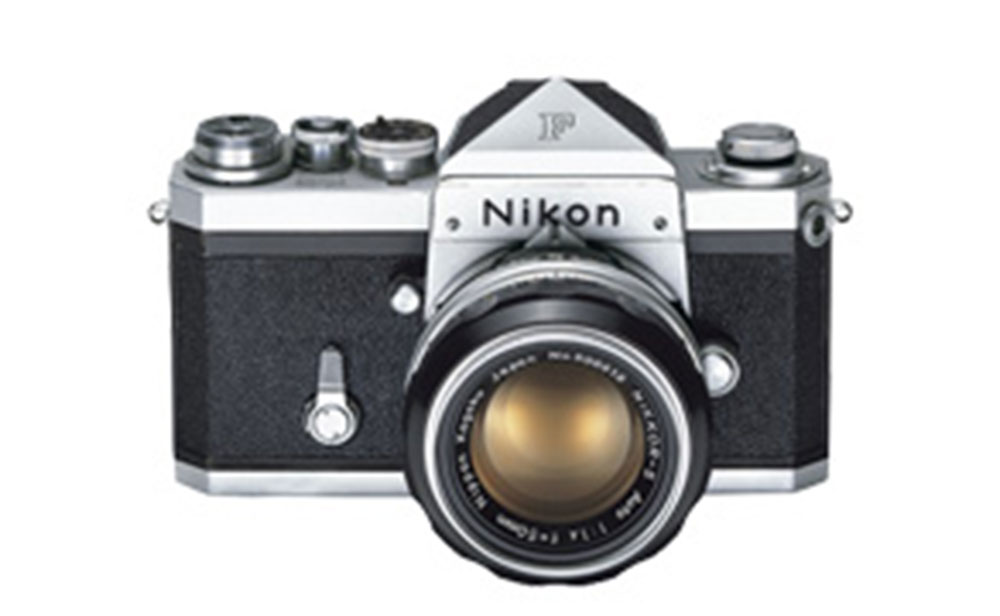
In February of 1957, the order was issued for prototyping 3 sets, signaling the start of the development of Nikon F.
At that time, the name of SLR cameras often included the letter R referring to Reflex (reflection), though the letter R sounds different phonetically in areas other than the English-speaking sphere; then, F was selected from Re-Flex for naming the Nikon F since the letter F is pronounced almost the same.
The Nikon F specifications are presented below.
| Lens aperture | Instant-return type, with focal depth monitoring button (stop-down button) |
|---|---|
| Mirror | Automatic instant-return type with lock-up facility available as necessary |
| Viewfinder | Interchangeable with waist-level viewfinder |
| Focusing screen | Split-image type and matt-type as standard, interchangeable with each other |
| Shutter | Titanium foil focal-plane shutter |
| Self-timer | Variable duration type |
| Flash synchronization | Variable according to time lag, sync. with Speedlight at a high speed (1/60 sec.), with JIS B type clip contact |
| Dimensions | Approx. 147x98x89mm (with 5-cm F2 lens) |
| Weight | Approx. 685g (body only) |
Development of Nikon F
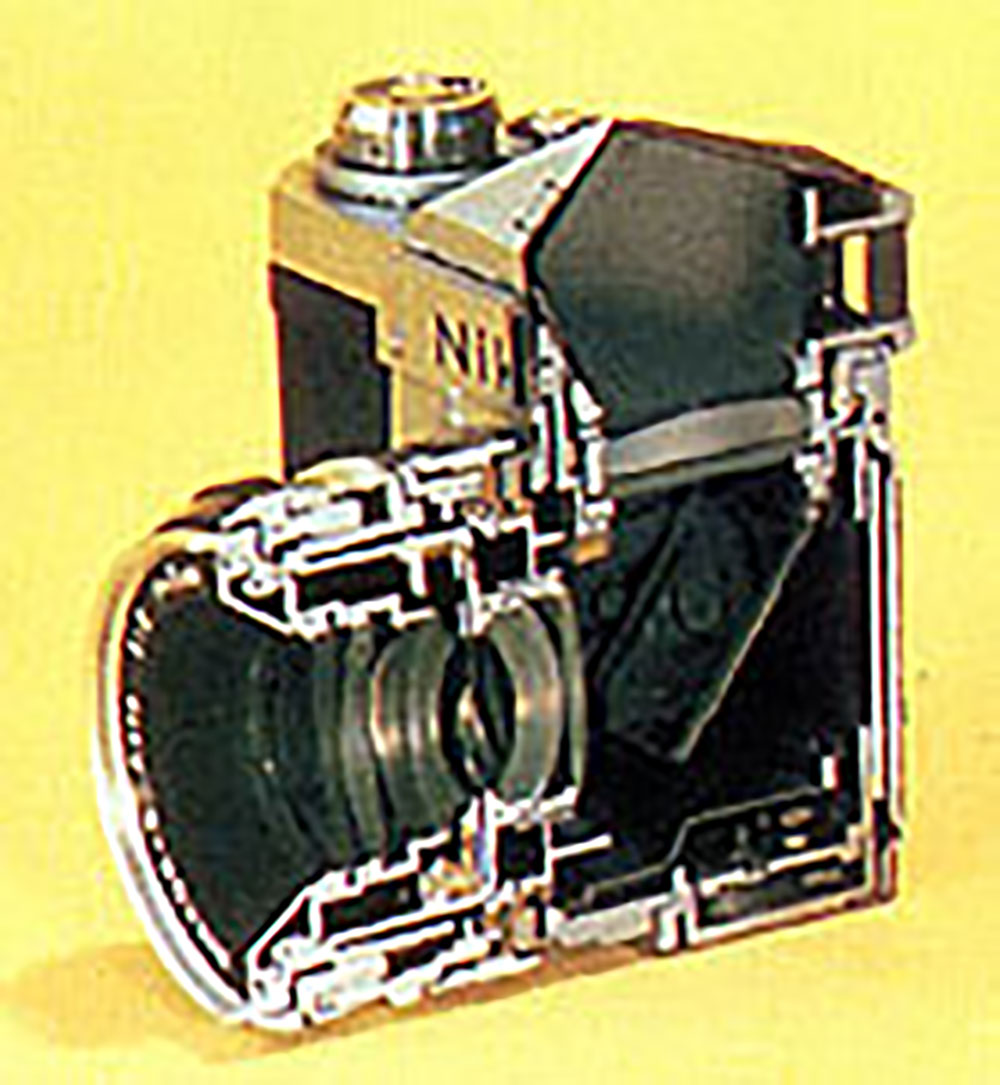
In the trial model, based on the body of the Nikon SP, the mirror box was inserted in the central part. Only the three principal components, mirror box, pentaprism and bayonet mount, were newly developed, and the other components were virtually identical to those in SP/S3.
In the development of the mirror box and pentaprism mechanisms, we had to resolve some important technical problems, including switching at high speed between the optical axis for the photographic system and the optical axis for the viewfinder system, with the reflex mirror.
The bayonet mount was constructed with stainless steel materials for excellent durability and corrosion resistance, to be able to bear the weight of the telephoto lens. In addition, φ44 mm (φ34 mm for Nikon S series) was selected for the inner diameter of the mount, allowing for the possibility of using lenses with a larger aperture in the future. This mount was Nikon's original breakthrough since it has been in use for over 40 years to date in the 21st century, without need for any change.
Moreover, the lens mounting knob and lens securing spring were installed on the body, rather than on the lens side as in many competitors' products.
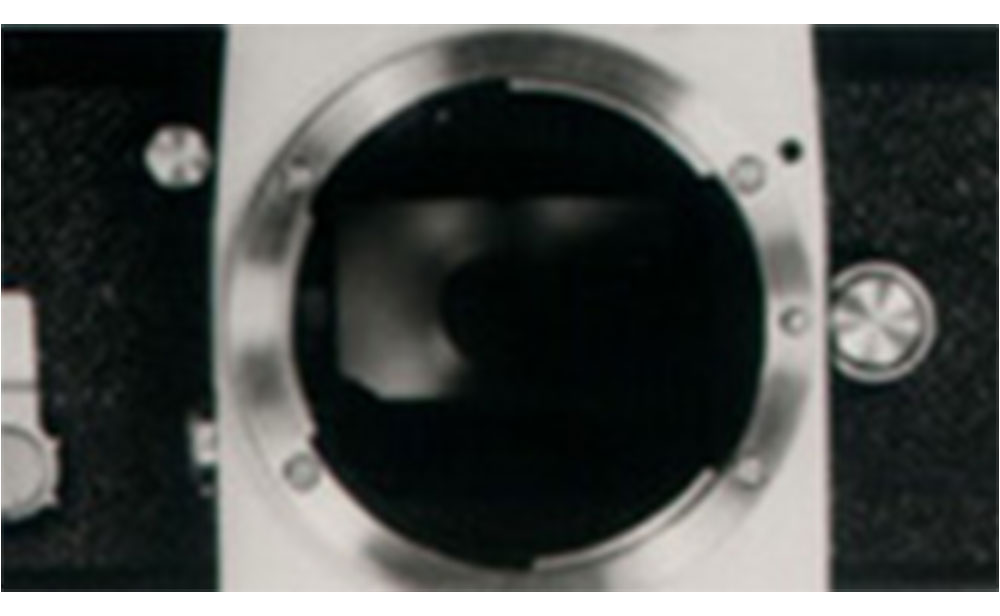
The viewfinder coverage was set 100%, taking full advantage of the fact that in SLR the visual field and the photographic screen are identical, and the image captured on film is the same as that visible through the viewfinder.
The visual field of the viewfinder was bright and easy-to-view, and the adoption of a large reflex mirror contributed to minimize image vignetting on the screen even when an ultra telephoto lens was used.
In addition, the viewfinder was detachable to ensure interchangeability with different types. The finder screen was designed also to ensure interchangeability with other types for different photographic purposes.
The viewfinder was designed to work with the automatic instant-return mechanism of the mirror and lens aperture (full-automatic aperture control mechanism), and set normally open except for the moment when the shutter operates, for easier viewing. In addition, a manual stop-down (preview) button to identify the depth of field at the shooting aperture used, and a mirror-up mechanisms to lock the reflex mirror up were also provided.
The shutter foil was constructed of titanium (0.02 mm in thickness) for the first time in the world after clearing various problems involved in the processing in order to ensure smooth operation due to weight reduction, enhance the mechanical strength, and prevent possible burnout by sunlight.
Concurrently with introduction of Nikon F, the shutter foil for Nikon SP was also changed from a fabric foil of habutae silk to titanium material.
To prevent blurring due to the activation of the mirror, one of the drawbacks of SLR cameras, we repeated the studies using the specifically developed shake recording device and succeeded in suppressing blurring to the lowest possible level, close to that achieved by the rangefinder cameras.
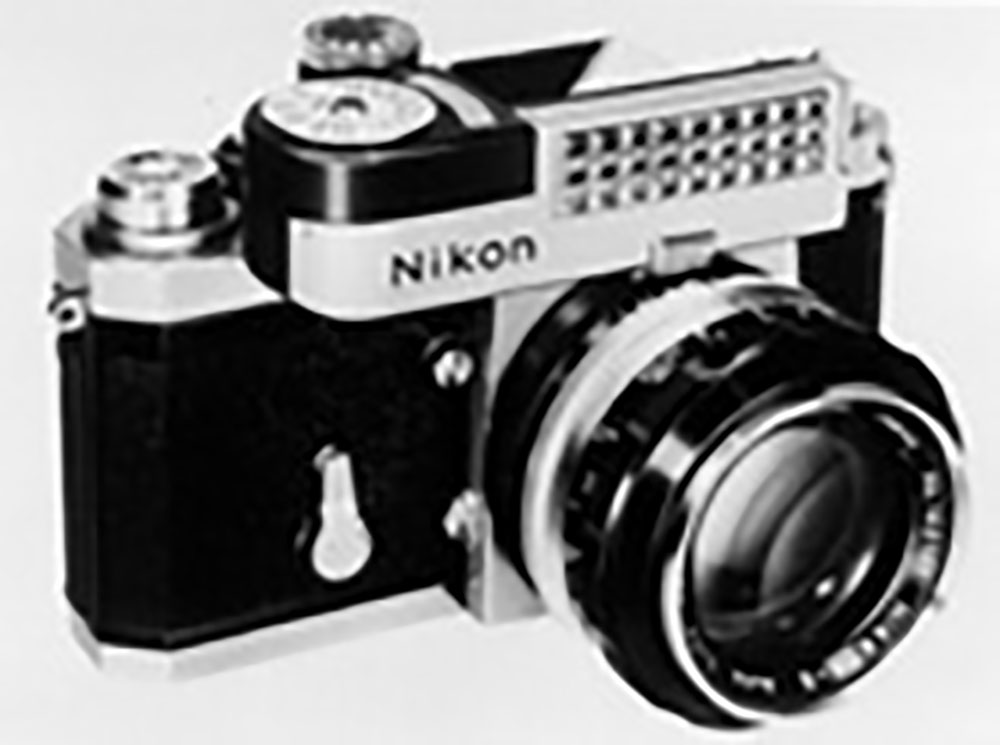
Nikon F was the world' first SLR to provide the full coupling of not only the shutter speed but also the aperture to the exposure meter Nikon Meter.
The accessories considered typically required for the system were made available at the initial stage. Particularly, the practical application of a motor drive in the SLR camera was first in the world (continuous shooting available at a rate of up to 3.6 frames per second).
Moreover, Nikon F, which contained many moving parts and complicated mechanisms, was repeatedly subjected to various tests including endurance, heat run, low temperature durability and vibration similarly to the tests for the S series, to ensure that it could withstand hard use under any conditions and provide a highly reliable camera. The shutter endurance test in particular consisted of 100,000 cycles of repetitive action in a short period of time with the aid of a motor drive including the coupling to the quick-return mechanism of mirror. Thus, essential requirements were also established as with the S series cameras, stating that the cameras should be free from any defect in reproducibility and mechanism.
The exterior of Nikon F was designed by Yusaku Kamekura, a graphic designer. Many SLR cameras in those days were relatively round in design, though Nikon F gained increasing favor for the straight line-based sophisticated body profile and the refined appearance such as the impressive engraving of the F mark, and was granted the Good Design Award (G Mark) in September 1966 as the first among Nikon's products by the then Ministry of International Trade and Industry (currently, the award is given by the Japan Industrial Design Promotion Organization, JIDPO).
Introduction of Nikon F on the market and expansion of F system
Highly regarded F
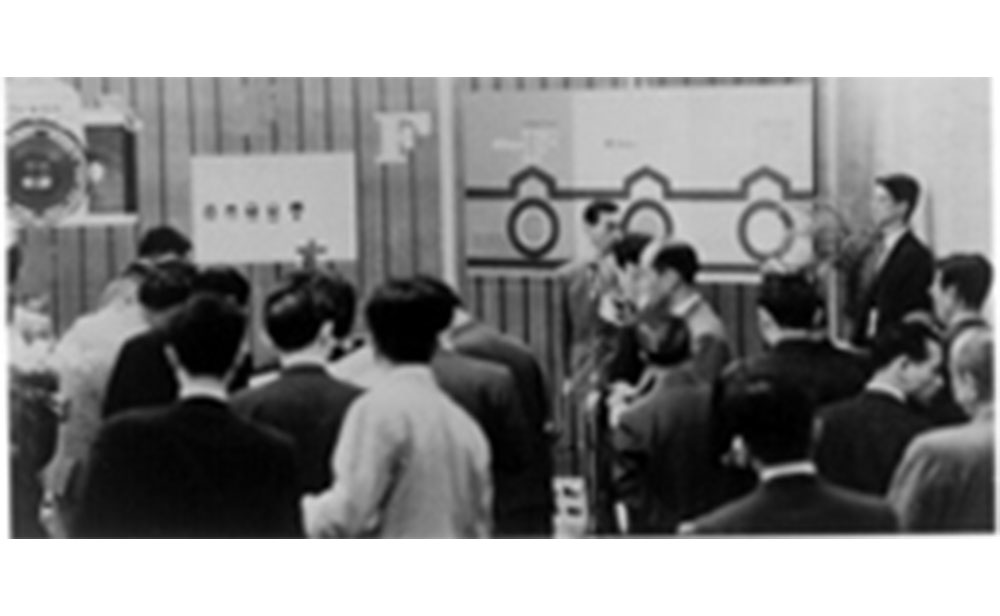
Nikon F was finally completed based on our technical know-how and skills and its introduction on the market was announced to the press in March 1959. A preview was held in April on a grand scale with the attendance of many people concerned with photography and the press in Tokyo as the starting point, then in Osaka, Nagoya, Fukuoka, and Sapporo.
Nikon F, introduced on the market in response to the expectations of users, was much talked about and received good reviews from camera magazines, such as: "Nikon F has resolved the mechanical problem of possible interference between the projecting rear element of wide-angle lenses and the SLR-specific springing-up mirror, thanks to its lens design..."; "The body and die casting are especially fine-grained and well-built. The guide rail in particular displays excellent workmanship,"; "Nikon F has implemented almost all requirements placed on 35 mm SLR cameras." (Asahi Camera, 1959 September issue).
We also actively conducted a sales campaign by holding a display with the exhibits on sale at the main branch of the Mitsukoshi Department Store in Nihonbashi to coincide with the first introduction on the domestic market in June.
At the time of release, the domestic consumer price (list price) of Nikon F was 67,000 yen (with 5-cm f/2).
In the United States, we announced the release of Nikon F in late March of 1959 in the exhibition "Philadelphia Show", an annual convention and trade show of the Photo Marketing Association held in Philadelphia, where we showed the product, and started to export to the United States in May.
In areas other than the United States, we started sample shipping to the overseas business contacts in July.

Nikon F created a great sensation after it was put on sale. In fact, in the first Japan Camera Show held in March 1960 at Takashimaya Department Store in Nihonbashi with a total attendance of 130,000 people in a 6-day period, the Nikon booth displaying the Nikon F system became popular among the visitors.
In overseas countries, we entered the product in the 7th Photokina in September 1960, where we also gained a good reputation. In addition, in the 8th Photokina in March 1963, the U.S. economic journal Business Week carried an article in the special issue stating "Finally Nikon has taken the initiative in the domain of high-end 35 mm SLR cameras."
Subsequently, we heard from all parts of the world about the excellent reception enjoyed by Nikon F.
In April 1963, the Everest expedition party composed of 20 American geographers purchased 20 Nikon F systems, photomicrography apparatus and other equipment. In view of the fact that the Japanese climbing party had been using the Nikon cameras over the past 10 years, it was reportedly decided to carry the Nikon F as the only SLR camera to withstand hard use in the severe environment.
The US Everest expedition party succeeded in reaching the summit in May, and Nikon F delivered a fully satisfactory performance in the recording of valuable measurements and investigations.
Nikon F also gained an increase in sales performance, not just a reputation as a typical model of SLR cameras, and the sales volume exceeded 200,000 in November 1965, 6 years after the release. The 200,000th Nikon F was presented to the photographer David Douglas Duncan (DDD) who made the Nikon and NIKKOR brand names known all over the world.
Expansion of Nikon F system
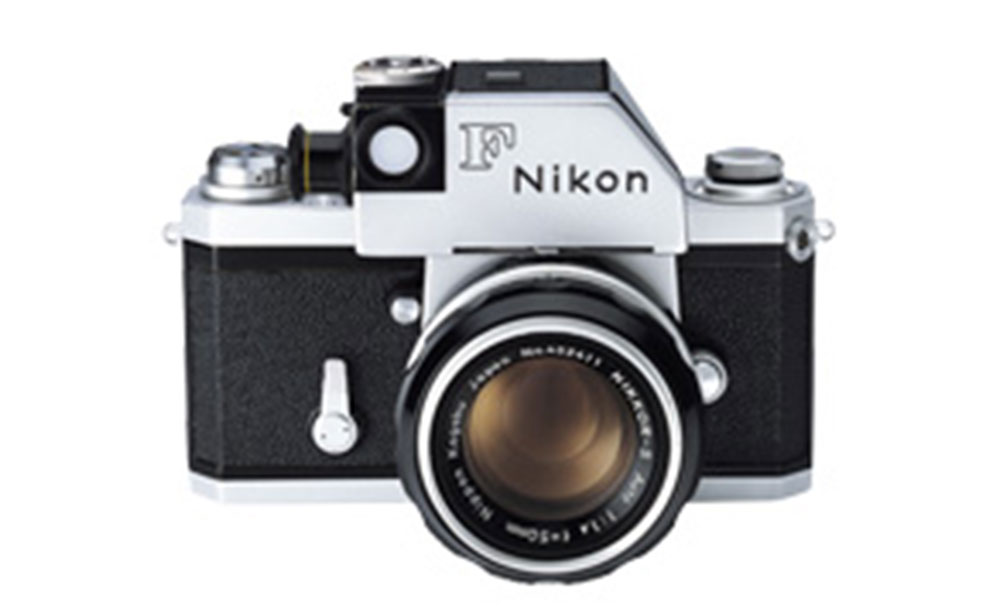
We succeeded in developing the Photomic View Finder featuring enhanced exposure measurement performance by combining a coupled exposure meter with an eye-level viewfinder and adopting CdS (cadmium sulfide) as photo sensor, and introduced the Nikon F Photomic on the market in April 1962 with the viewfinder installed in the body of Nikon F.
The exposure meter was the fixed point-alignment type based on external exposure measurement, and the meter indicator was visually identifiable either through the visual field of the viewfinder or externally.
In September 1965, Nikon F Photomic evolved into Nikon F Photomic T with the viewfinder changed to the TTL system for measuring the average light over the entire region by improving the photo sensing mechanism of Photomic View Finder. This was the world's first adoption of TTL metering into the viewfinder-interchangeable SLR camera, and the metering could be attained either by setting the lens aperture open or actually stopping down the aperture.
In August 1960, the long motor drive, F-250 went on sale to deliver 250 exposures. It used one-third of 100-feet (approx. 30.5 m) film. It served as a powerful weapon for Nikon F system, though the mean annual sales volume was 220 for several years after the release.
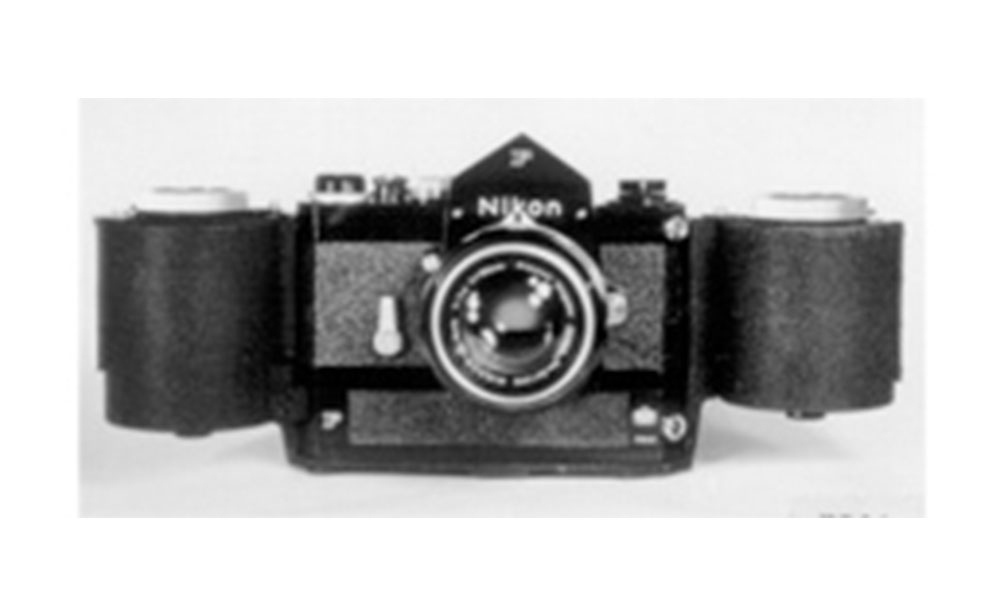
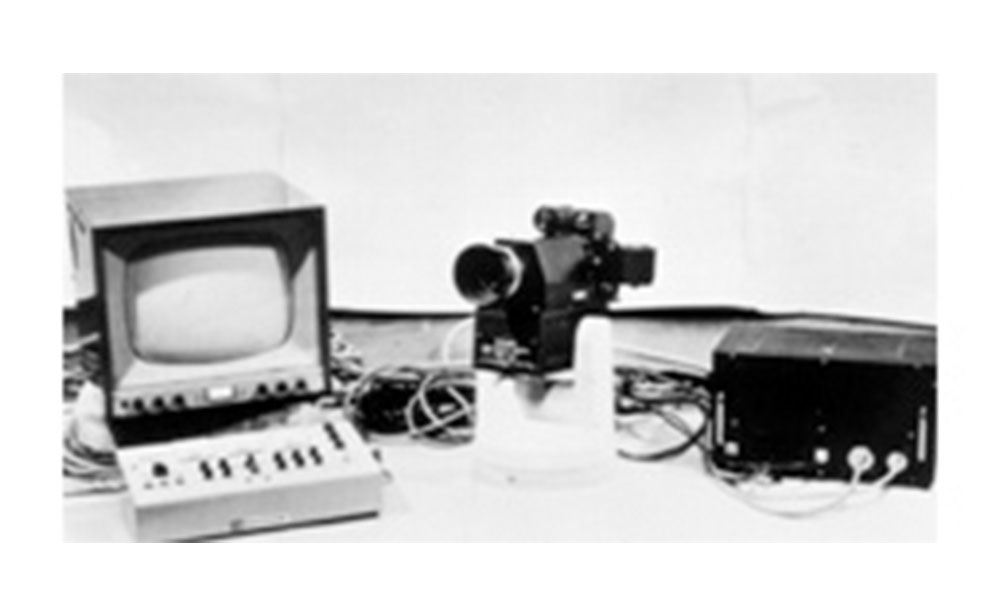
Afterwards in 1962, Nikon Video Remote Control (TV remote-controlled recording unit) was manufactured by combining the Nikon F, the 250-exposures motor drive, and Auto NIKKOR Telephoto-Zoom 8.5 - 25cm f/4 - 4.5 with the intent to simultaneously provide the supervisory and measurement by TV and the recording and photography by camera, which gave an impression of multifunction Nikon F system.
Nikkor lenses supporting the system
Lens lineup supporting the philosophy of Nikon F system

Among the optical systems configured with the Nikkor lenses which had been established in the commercialization of the coupled range finder camera Nikon S series, some telephoto lenses could be applied directly to Nikon F without any modification.
In practice, however, since the reflex mirror must be located between the lens and film in the SLR cameras and then, we projected to develop a new lens system of retrofocus (inverted telephoto design) type providing a longer back focus (a distance between the rearmost portion of the lens element and the focal point) for the lenses of shorter focal length and succeeded in materializing the lens configuration excellent in every factor of lens aberration, resolving power, flare, brightness of the edge of the image field, and spectral transmittance.
Concurrently with Nikon F, we released the full-automatic aperture control mechanism-integrated NIKKOR-S Auto 3.5cm f/2.8, NIKKOR-S Auto 5cm f/2, NIKKOR-P Auto 10.5cm f/2.5, NIKKOR-Q Auto 13.5cm f/3.5 and other lenses dedicated for the F and three models of lenses used for both S and F.
Then in December 1959, Auto NIKKOR Telephoto-Zoom 8.5 - 25cm f/4 - 4.5, the world's first telephoto zoom lens for still cameras, was commercialized and the first one was delivered to a newspaper company.
In the same month, the ultra wide-angle lens NIKKOR-O 2.1cm f/4 was introduced for use with the reflex mirror in the camera set up.
The table below presents the products put on sale 1960 through 1963.
| 1960 | Fast speed standard lens NIKKOR-S AUTO 5.8cm f/1.4 Retrofocus (inverted telephoto) type wide-angle lens NIKKOR-H 2.8cm f/3.5 Lightweight type telephoto lens NIKKOR-T 10.5cm f/4 |
|---|---|
| 1961 | Micro-NIKKOR Auto 5.5cm f/3.5 for precision copying NIKKOR-Q Auto 20cm f/4 |
| 1962 | Fast speed standard lens NIKKOR-S Auto 5cm f/1.4 Fisheye lens Fisheye-NIKKOR 8mm f/8 PC-NIKKOR 35mm f/3.5 allowing swing & tilt photography Ring light-integrated, medical-use Medical-NIKKOR Auto 200mm f/5.6 |
| 1963 | Standard zoom lens Zoom-NIKKOR Auto 43 - 86mm f/3.5 |
The lenses listed above offered the superior optical performances and also provided a variety of mechanical features. For example, the lens barrels were constructed with highly corrosion-resistant free-cutting light alloy to offer the reduced weight feature, and the focal point adjustments were all linear helicoid design to ensure ease of use.
For the screw thread for attachment mounting at the leading edge of lens barrel, the diameter of 52 mm was adopted as standard for daily use lenses to allow compatible application of filters and other accessories.
In addition, the aperture-stop graduations were evenly spaced, and the Nikkor Auto series of lenses were provided with our original mechanism to allow coupling to the exposure meter Nikon Meter through the claw on top of the aperture ring.
Expanding our market
Broadening our product range to lower-price models of SLR
Around 1955, the leisure-oriented times started. In addition, as the postwar generation nuclear family increased, cameras became more widely popular and the market expanded focusing on the lower-priced 35 mm (135) format lens shutter cameras offering ease of operation for amateurs and the coupled exposure meter.
Nikon had been based on the corporate strategy of "ensuring superiority in the high-end camera market" and thus, we had no lower-price popular model at that time around 1955 to answer the demand and then failed to increase the sales of camera.
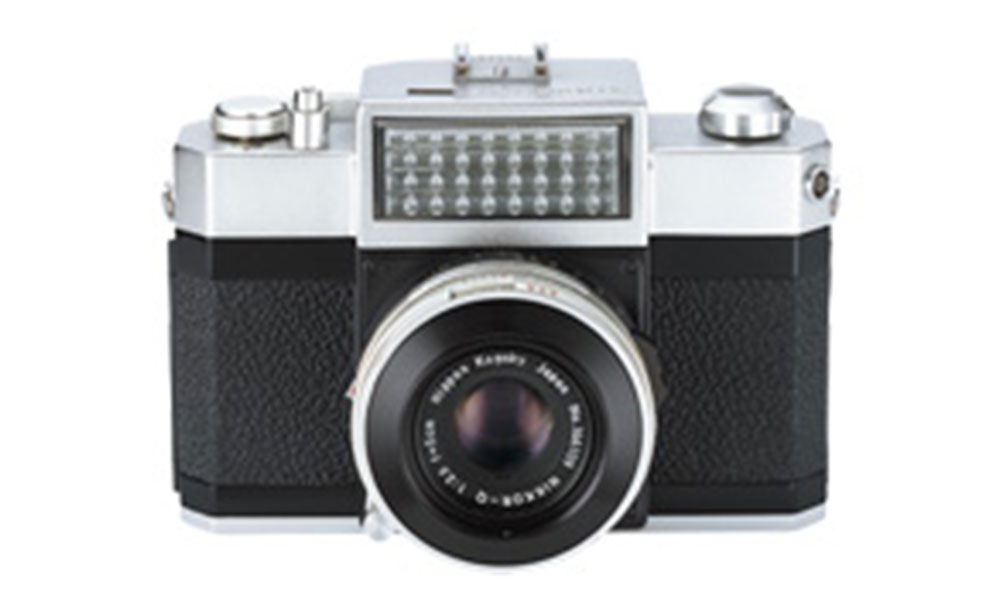
Then, considering that we must supply popular models answering the user needs in order to expand our market, we introduced on the market in March 1960 the full-coupled exposure meter SLR camera NIKKOREX 35 (with Nikkor 50mm f/2.5 (fixed)) at a consumer price of 22,300 yen with the lens shutter and the viewfinder of polo mirror system (an optical system configured with 3 mirror elements to work similarly as the pentaprism).
The (front) conversion lens 35mm F4, 90mm F4 was made available optionally to accommodate the wide-angle and telephoto photography.
In actuality, however, in the lower-priced model market, the coupled range finder lens shutter cameras were prevailing, there were many similar products from competitors and we were exposed to hard fight. Then in April 1962, we released the NIKKOREX 35II (35/2) (with Nikkor 50mm f/2.5 (fixed)) by considerably modifying the internal design of NIKKOREX 35 to increase the durability and also by reducing the price to 19,800 yen.
On the other hand, the mainline high-end models shifted to Nikon F and other SLR cameras after the production of 35 mm rangefinder focal-plane shutter cameras reached the peak of 130,000 in 1959.
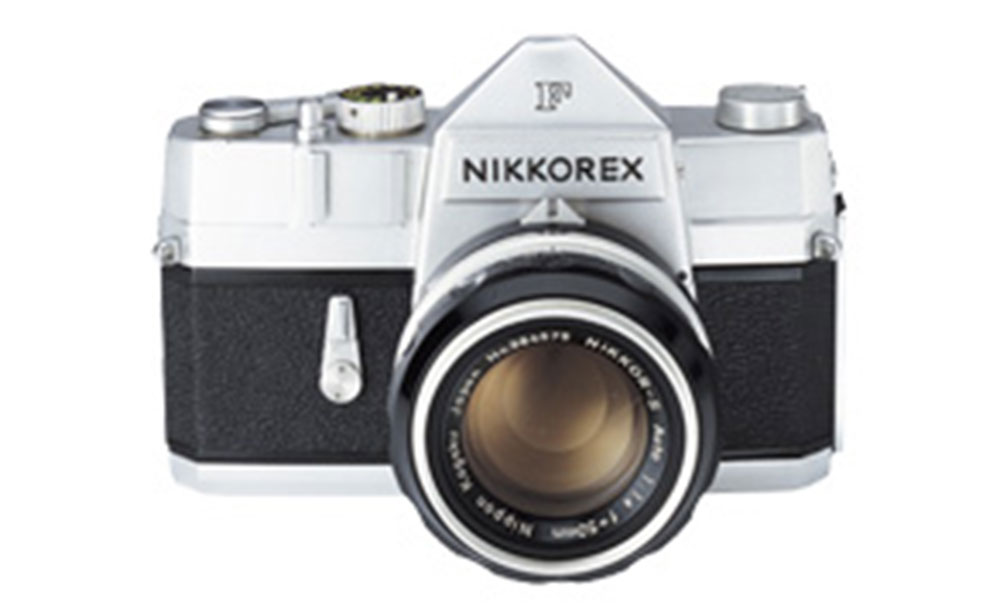
Under the circumstances, we introduced NIKKOREX F in June 1962 as the sister version of Nikon F at a consumer price (net price in cash) of 49,300 yen for the models with 50mm f/1.4 and 39,800 yen for the models with 50mm f/2 with the intent to drive up the demand for SLR cameras.
The NIKKOREX F featured direct use of almost all of the lenses and accessories for Nikon F, and adopted the Copal Square shutter (vertical running metal focal-plane shutter unit) provided by the then Copal Co. (the present NIDEC COPAL ELECTRONICS CORP.) which allowed synchronization of Speedlight at 1/125 sec.
The NIKKOREX F provided the full coupling to the dedicated exposure meter (the improved version of Nikon Meter II-type) similarly as Nikon F for both aperture and shutter speed.
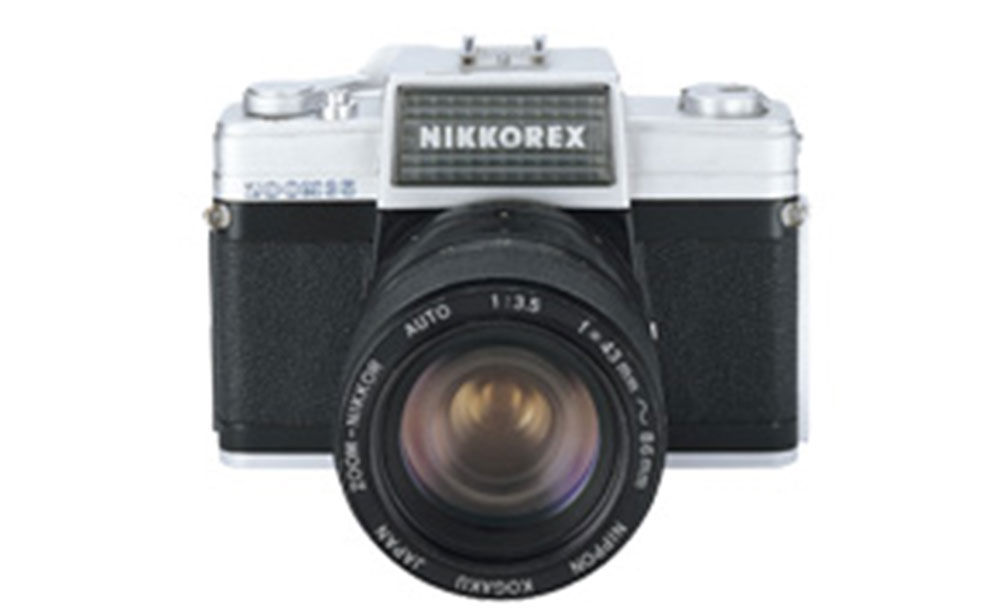
In February 1963, the lens shutter SLR NIKKOREX Zoom35 (39,500 yen) went on sale based on the combination of NIKKOREX 35II and a newly designed zoom lens 43 - 86mm f/3.5.
The NIKKOREX Zoom35 offered the capability of continuous scaling from wide angle to telephotographic range without need for changing of lenses, taking full advantage of SLR cameras, and thus gained the spotlight as "the camera with the zoom lens installed on a popular model camera."
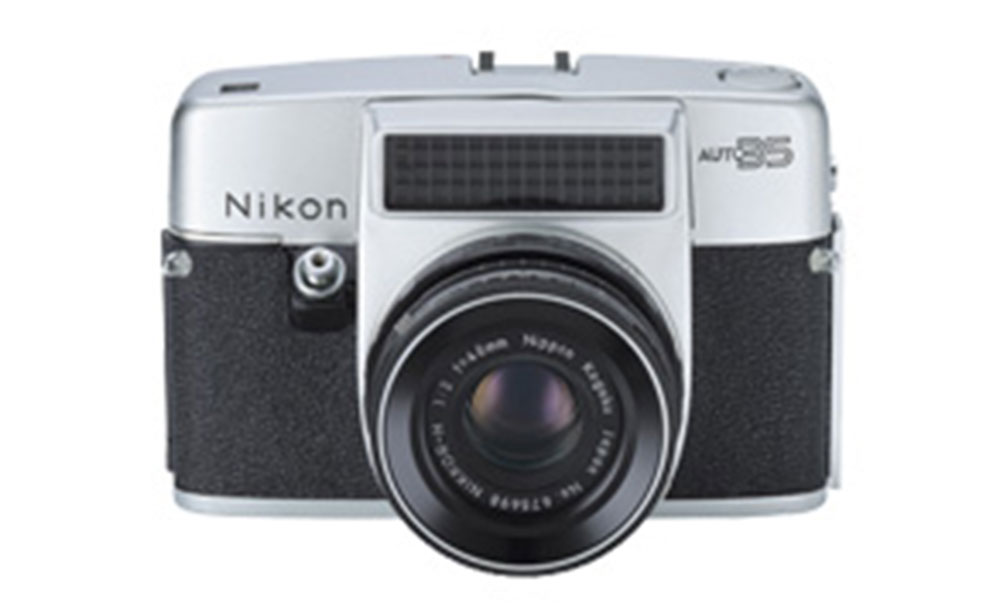
In addition in September 1964, we released the new model Nikon AUTO35 (with NIKKOR 48 mm f/2 (fixed) at 29,000 yen), featuring our first camera equipped with automatic exposure control (EE = Electric Eye), as a substitution for NIKKOREX 35II. The Nikon AUTO35 was characterized by the ease of use of SLR camera plus the convenience of EE and the shutter speed selective EE mechanism.
It was also configured with the quick-return mirror to provide Nikon's first lens shutter SLR.
This model was available with the wide-angle and telephoto (front) conversion lenses and a full lineup of multi-use adaptors for a wide variety of photographic purposes, and the design was novel enough in that the triangle of pentaprism on the SLR camera was not projected above the body battleship.
It was also novel that the model was released under the Nikon brand.
Introduction of Nikomat
While the 35 mm SLR cameras were enjoying popularity, popular models, lower-priced models, EE integrated models and other new models appeared in succession. Accordingly the sales war became intensified, and the influence spread also to our popular model SLR cameras. Then, in July 1965, we introduced the SLR cameras, Nikomat FT and Nikomat FS, to substitute as the sister versions of Nikon F for NIKKOREX F (1962).
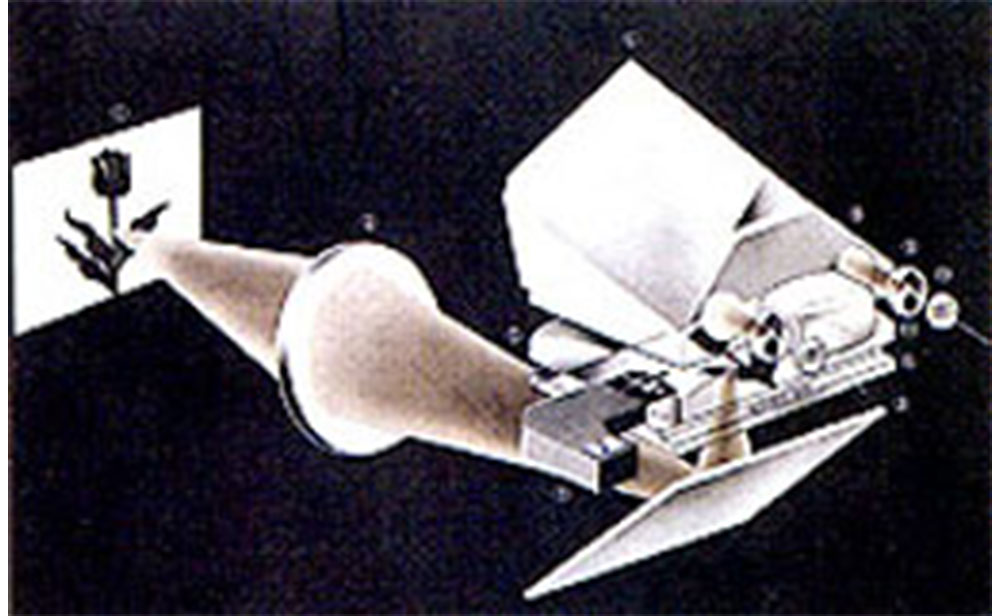
The key feature of the Nikomat FT was the built-in conversion-type TTL metering mechanism, our first system for measuring the average light over the entire region, to allow exposure measurement by either system, that is, TTL metering at full aperture or stop-down metering. The successful development of the TTL metering system was inspired by the fact that coupling to shutter and lens aperture would be achieved easily, based on the limitations in structure of the newly designed Copal Square S unit adopted as the shutter involving the forced installation of the shutter dial on the lens mount.
In addition, despite the metal focal-plane shutter, the shutter sound was low enough, and the Speedlight was synchronized at 1/125 sec.
Moreover, the lenses and accessories could be shared with Nikon F, and the quality and design were both comparable to those of high-end models, though this model was aimed at a popular version of high-end SLR cameras. This meant this model?fs image followed in the footsteps of Nikon F. The consumer price was 54,500 yen for the models with 50mm f/1.4.
The concurrently released Nikomat FS was a popular model with a built-in exposure meter and mirror-up device removed from FT, and it was sold at 37, 800 yen for the models with 50mm f/2.
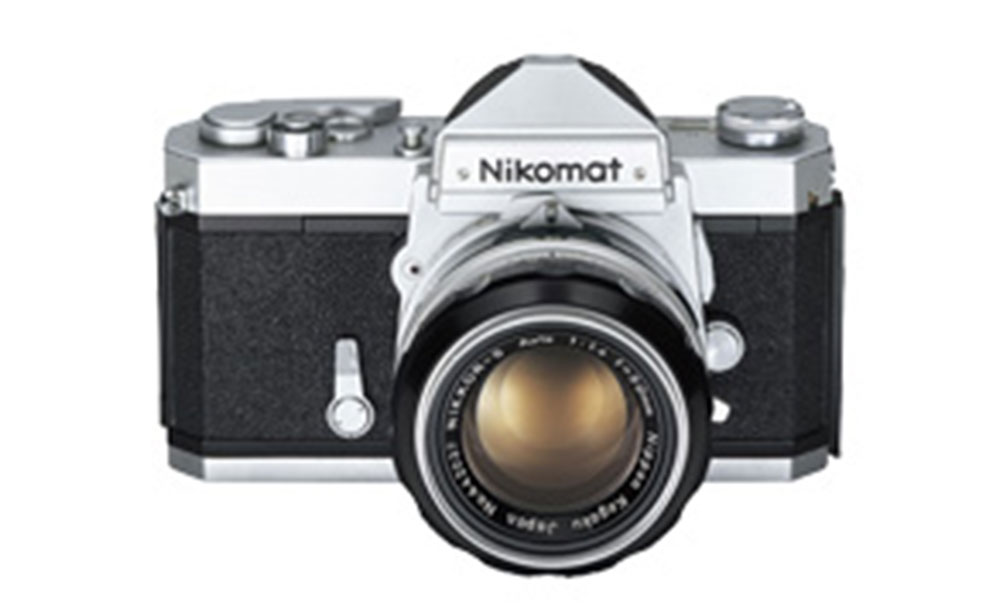
With the release of Nikomat, we carried on a large-scale advertising and PR campaign setting the camera as a strategic model for market share expansion. To commemorate the release, we held a Nikon Fair in various parts of Japan, sponsored TV programs broadcast throughout the country, and carried on an extensive advertising and PR campaign including advertising posters in trains on the lines of the then Japanese National Railways [JNR, the present JR East (East Japan Railway Co.) and JR West (West Japan Railway Co.)] at Tokyo and Osaka and various private railways, advertisements in newspapers, magazines and other printed media, and movie spots put on in road-show theaters in central Tokyo.
In addition, as the strategy for sales promotion, we opened briefing sessions for camera shops in each district, and distributed a Sales Guide to the leading shops in particular to deliver the selling points of Nikomat accurately in detail.
Nikomat FT specifications are presented below.
| Viewfinder | Pentaprism fixed type |
|---|---|
| Lens aperture | Full-automatic preset type with stop-down button |
| Mirror | Quick-return type with mirror-up facility |
| Finder | Eye-level type |
| Focusing screen | Micro-prism type |
| Metering system | TTL entire region TTL metering at full aperture, Metering range: f/1.4 at 1/4 sec. to f/11 at 1/1,000 sec. at ASA (the present ISO) 100 |
| Shutter | Vertical running metal focal plane (B, 1 to 1/1,000 sec) |
| Flash sync. | M and X, automatic time-lag adjustment, Speedlight synchronized at 1/125 sec. |
| Dimensions | Approx. 148x95x88mm (with 50 mm f/2) |
| Weight | Approx. 745g (body alone) |
Development of all-weather camera NIKONOS
In May 1961, the French Aqualung (simplified diving apparatus) maker LA SPIROTECHNIQUE developed a new type of 135-format watertight camera Calypso (named for a nymph in Greek mythology), and contacted us out through the then Teikoku Sanso KK (the present Teisan Co.) about production and marketing.
In 1956 we had developed a housing to hold the Nikon S2 for underwater photography, and introduced the underwater camera in May under the brand name of Nikon Marine. Then we made improvements by combining also the bodies of SP and S3 in addition to the body of S2 (No. 66141001 and later) with W-Nikkor 3.5cm f/2.5 and W-Nikkor 2.8cm f/3.5 lenses to allow use of W-Nikkor 3.5cm f/1.8 lens. However, the housing-based Nikon Marine was heavy and expensive, and quite different from Calypso in the technological and functional aspects as well as in marketability.
Realizing that this product involved original ideas, had sufficiently high performance, and its export potential was promising with higher marketability, we formed a technical tie-up with LA SPIROTECHNIQUE in January 1962, and acquired the exclusive production rights and also the exclusive sales rights except in France and EEC (the European Economic Community of that time).
The watertight camera offered a variety of features including those listed below, with the aid of perfect air-tightness by the O-ring and perfect waterproofing in the die-cast sections.
- 1.Compact and lightweight, thereby ensuring easy and simple operation,
- 2.Useful in many application fields as an all-weather camera not only underwater (usable to a water depth of 50 m for photography) but also on land, and
- 3.More cost-effective compared to the conventional housing-based design.
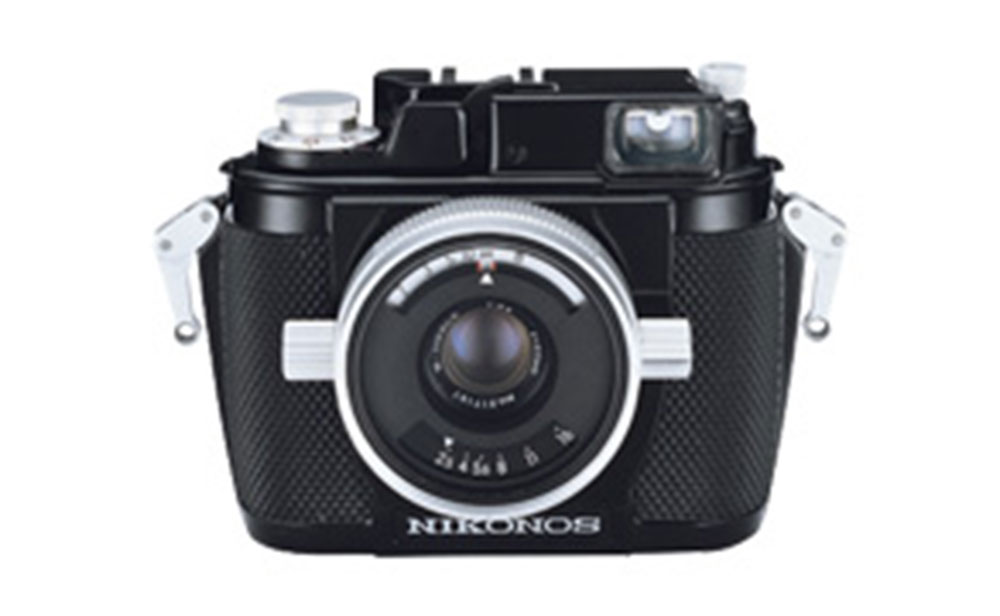
We considered the camera as an "all-weather camera" for its highly water-resistant, pressure-tight, corrosion-resistant properties and other durable mechanisms not attained by any other cameras, and decided to sell it under the brand name of NIKONOS.
For the lenses, the wide-angle lenses for land and water use W NIKKOR 35mm f/2.5 and underwater-specific U•W NIKKOR 28mm f/3.5 were made available. The front waterproof glass of the 35mm f/2.5 lens was flat, while the underwater-specific 28mm f/3.5 lens had a biconvex lens and this front waterproof lens and water combination formed a single lens to help correct any distortion and/or chromatic aberration in the water. In March 1963 prior to the formal announcement of the introduction, we entered NIKONOS in the 8th Photokina as a new product, and the idea of hanging the NIKONOS in a water bath in which goldfish were swimming attracted the attention of visitors.

The camera was put on sale domestically in August 1963 at a consumer price of 28,500 yen (with 35 mm f/2.5), and was favorably received as an unprecedented handy watertight camera in a variety of sectors including academic research, underwater photography, oceanic research, civil engineering, and construction. In the first half of the next year 1964, the statistics on sales volume of 35 mm cameras by model showed that this model achieved the mean monthly sales volume of 1,300, next to Nikon F. In August 1966, a special issue of World of Wide was published, carrying the photographs taken by photographers active at the forefront using the NIKONOS regularly, and distributed to Nikkor Club members, camera shops and other parties and individuals involved in publicizing the camera's characteristics.
NIKONOS then evolved into NIKONOS-II (version) through the improvement of the film wind-up mechanism (to a crank from a knob) and film pressure plate (to a pressure plate with hinged design) for easier film changes, which went on sale in 1968.
Since then, the original NIKONOS has been known as NIKONOS (version I).
Later in 1975, NIKONOS III came out with a sprocket for film wind-up (up to then, the wind-up amount had been adjusted by gradually decreasing the angle of rotation of the spool with every frame), a film counter, improved flash sync connector, viewfinder modified from the Albada type to the illuminating window bright frame type, and an additional frame for the 80 mm lens.
Reinforcing the sales promotion activities
Production of cameras in Japan exceeded 1 million in 1956 and remained active for the decade with a growth rate of over 10%. In 1962, Japan surpassed West Germany (Federal Republic of Germany), the leading camera supplier, in both production and sales, and became the number one camera producer in the world. Japan surpassed West Germany in 1967 in export volume and in 1964 in export amount.
In the domestic market, in response to the reduction of the commodity tax in 1962 to 20% from 30%, the price of cameras also dropped, thereby attracting consumers, which contributed to the earnings of camera makers, leading to consistent increases in revenues and profits for individual makers.
On the other hand, however, sales competition became more intense. Around 1965, discount products from supermarkets and other sources appeared on the end market, and underselling of Japanese cameras occurred also on the international market around 1963 and it was urged to take proper countermeasure.
As the competition to offer new models and reduce the list prices became increasingly fierce, we reinforced the tie-up with retail stores and carried sales promotion campaigns, focusing on the users directly.
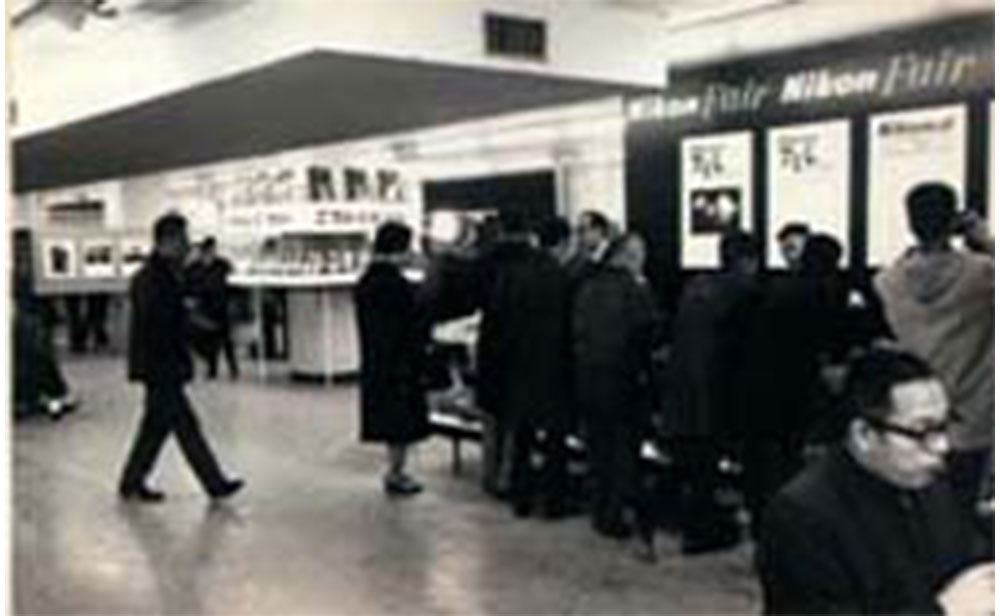
We had been entering the Nikon products in various exhibitions and events including the Japan Camera Show held every year since the start in March 1960, the Japan International Trade Fair held every year alternately at Tokyo and Osaka, the Special Exhibition on Light Machinery held in Mexico City or Hamburg, Germany, and we represented the camera industry at the New York World Expo (1964 to 65).
As our own project, to commemorate the release of Nikomat, we held the Nikon Fair at Keio Department Store in Shinjuku, Tokyo from the end of July 1965 thru early August, which attracted 120,000 visitors during that period. Thereafter, every year, we held a Nikon Fair in the main cities of Japan to both show all camera models and to exhibit photographs.
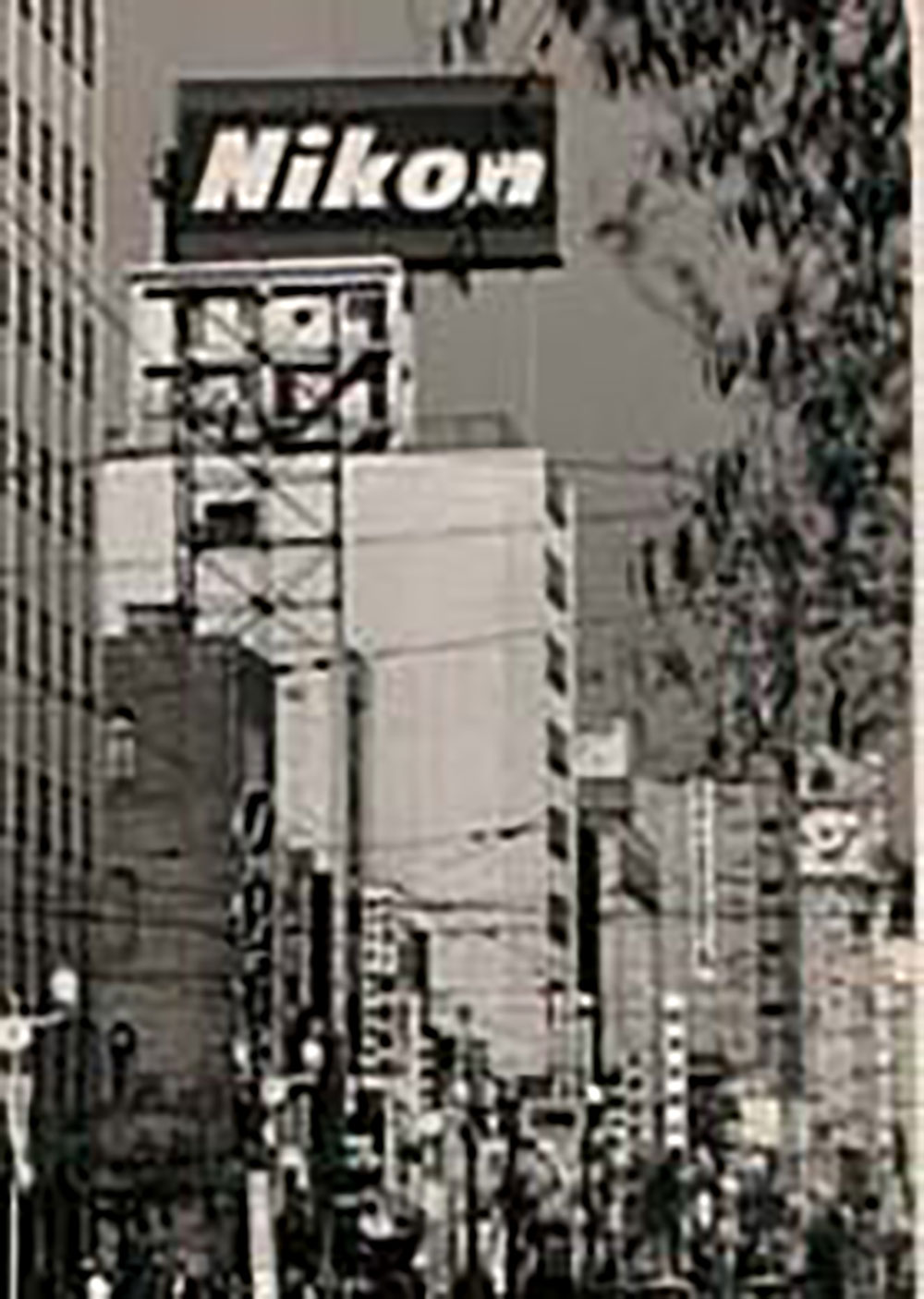
In December 1965, we installed the Nikon neon sign in Ginza, Tokyo (on the rooftop of Kinjo Shokai at 7-chome, Ginza, Chuo-ku), which attracted much attention. In addition, big names from various fields both at home and abroad visited us or appeared in newspapers and/or magazines as regular user of Nikon products, which had a strong advertising impact.
For the promotional sales activities for camera shops, upon forming the basis for sales channels in August 1962 with the start of Nikon Membership, we strengthened the connection with dealers and first issued the (monthly) Nikon News in March 1965 for distribution to a total of 5,200 Nikon dealers across the country as a service for the dealers.
On the international scene, we presented the Award for Photograph Promoting International Understanding to the winners of the Award for International Understanding through Photography (founded in 1957) which is given by the Photographic Society of America to brilliant photographic artists who worked hard to further international understanding through photographs.
Nikon presented the three-story pagoda of pure silver as a supplementary prize to a total of 11 winners, starting from the first winner Edward Steichen, the second winner Henri Cartier-Bresson, including Walt Disney (5th winner) and D. D. Duncan (6th winner). thru Alfred Eisenstaedt, the 11th winner in 1967.
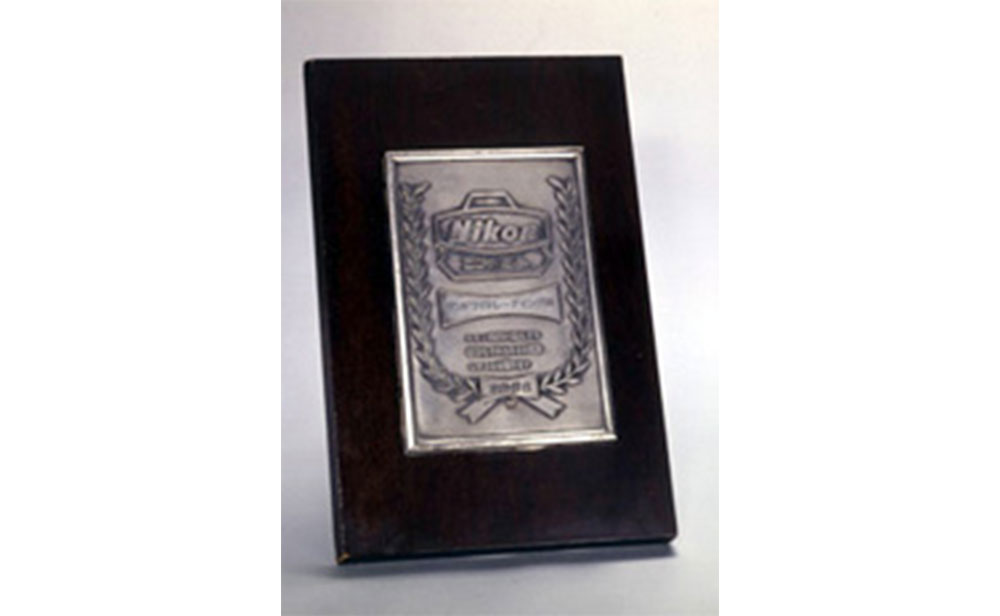

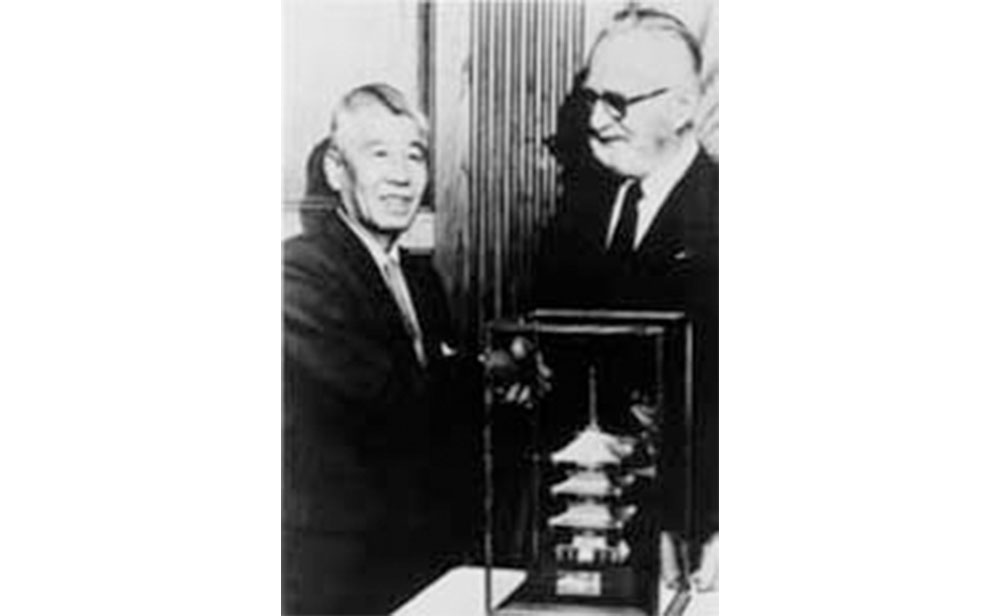
As mentioned above, backed up by the high appraisal and reliance from customers of Nikon F and Nikkor lens series, we actively carried out promotional sale and advertising activities and established a footing towards a "World-wide Nikon."
Tokyo Olympic Games and Nikon
Shift of leading news photo equipment to 35 mm camera from Speed Graphic

Since the market debut of Leica I (version) in 1925 which helped elevate the 35 mm (135) format compact cameras to the status of precision equipment, the 35 mm cameras became popular among professional photographers in Western countries for taking news photos due to the easy-to-carry and transport features.
Also in Japan, since before the Second World War, some photographers had been using the Leica or Contax (released in 1932), though the large press cameras were chiefly used for newspaper and news photographs. For newspaper photos, the subjects are varied but it is sufficient to take one decisive shot. Therefore, in those days cameras were expected to offer versatility rather than portability, and large-format cameras were in great demand.
After the Second World War, the press photographers assigned to the American forces stationed in Japan carried the 4x5 in. format SLR Speed Graphic manufactured by Graflex Inc. in the United States. The Japanese newspaper companies and news agencies looked at the high performance of the SLR and adopted the camera one after another.
The Speed Graphic was versatile and easy-to-use with such features as: (1) photographs could be developed one by one, (2) negatives were easy to evaluate without need of enlargement, and (3) trimming was easy to perform, all of which was advantageous for newspaper companies which cannot afford to waste a moment in preparing every photographic article.
For these reasons, the Speed Graphic became the "passport of newspaper photographers."
On the other hand, after the Nikon cameras and Nikkor lenses became highly regarded by the LIFE magazine photographers in 1950, it was generally recognized that the small format cameras would be more favorable for imaging moving subjects in several shots. Accordingly, the use of 35 mm cameras became widespread among photographers who were active in the field of graphic journalism by offering photos for publications and news reports.
Particularly since the introduction of Nikon S2 in 1954, as a substitute camera for Speed Graphic, the 35 mm cameras were more widely used. In fact, twenty to thirty percent of the news photos carried in the Asahi Shimbun Collection of (Best) News Photos and Yomiuri Collection of News Photos published in around 1955 were taken by the 35 mm cameras. Then, around 1960, use of the 35 mm rangefinder cameras with wide-angle lens was firmly established.
The accelerated adoption of 35 mm cameras could be explained by the features offered: a full lineup of interchangeable lenses, and Speedlight (electronic flash) and other such accessories were available to refine the images taken with 35 mm cameras; peripheral conditions were improved including the enhanced performance of 35 mm film and the automated and accelerated developing process around 1955; and there rose a growing demand for an increased volume of photographs due to the increased number of newspaper pages and the expansion of general news pages, in addition to the growing emphasis on the graphic pages in newspaper and publications around 1965.
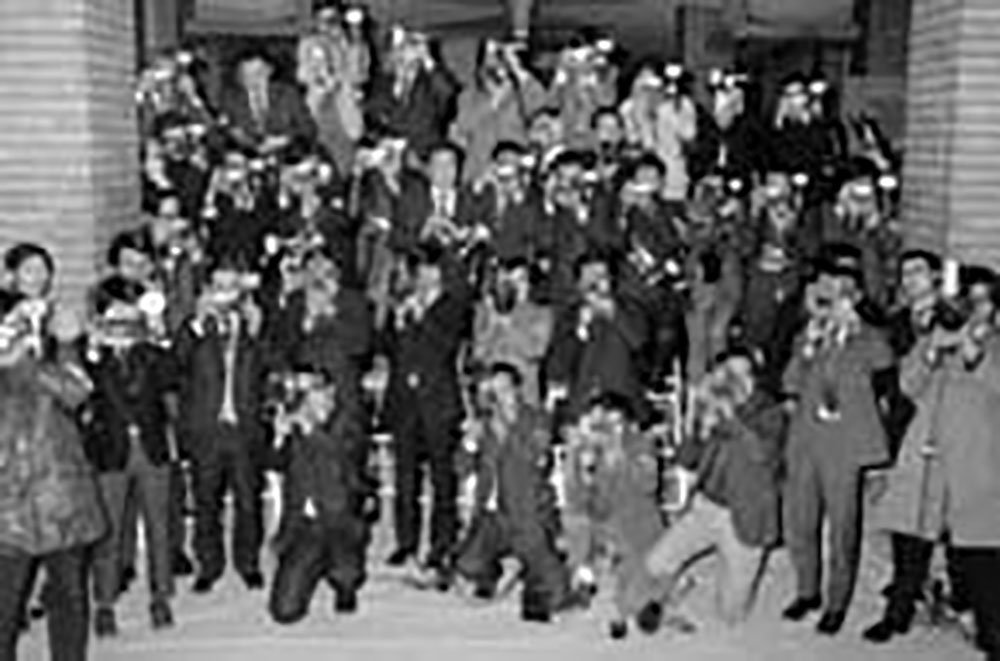
On the other hand, the 35 mm SLR cameras were used only as a test in most cases before the Nikon F went on sale in 1959. However, once the Nikon F became highly regarded for its performance and system, the SLR cameras with telephoto lens became commonly used and around 1965, eighty to ninety percent of news photos were shot with the 35 mm cameras including the coupled range finder model and SLR model.
Around 1960, most of the newspaper companies and news agencies in foreign countries also adopted the 35 mm cameras represented by Nikon SP (with wide-angle lens) and Nikon F (with telephoto lens).
Then, with the opening of Tokyo Olympic Games in 1964, Nikon replaced Speed Graphic as the representative news camera. In 1967 the retrofocus type interchangeable lens NIKKOR-N Auto 24mm f/2.8 for SLRs went on sale and thereafter, it became a common practice to use the Nikon F also for wide-angle photography, and there was a shift to the age of 35 mm SLR cameras.
Following the widespread adoption of 35 mm cameras by the newspaper companies and publishing houses, Nikon cameras were often selected as official equipment. This may be due to the fact that the motor drives were available, a full lineup of high-performance interchangeable lenses was available, and the cameras were robust enough to withstand any hard use. The decisive factors for the selection, however, were Nikon's corporate philosophy to pursuit higher performance and enhance reliability and Nikon's service system to support the news cameramen.
A battery of Nikon F cameras
The Olympic Games are watched by all the world with keen interest, thus offering a theater of activity for the news cameramen to compete with each other. Therefore, every company in every country focused all its efforts and used new and powerful equipment.
At the Olympic Games at Helsinki (Finland) in 1952, the cameras of the then Nippon Kogaku KK first appeared as the news photography cameras for the Olympics. At that time, Nikon S-type was used only to take snapshots of participants on the spot.
From the Melbourne Olympics (Australia) in 1956, Nikon S2 (1954) came to take an active part in photographing the competitions as a substitute camera for Speed Graphic.
Then, in the Rome Olympics in 1960 (Italy), the leading news-photography role was transferred to the 35 mm camera, and the news cameramen from all parts of the world hung the Nikon SP (1957) or S3 (1958) around their neck, and the F (1959) and Nikkor telephoto lenses were used in the stands, leading to an expanded arena for Nikon cameras.
Especially in cases when the photographic location could not be changed, Auto NIKKOR Telephoto-Zoom 8.5 - 25cm f/4 - 4.5 demonstrated its outstanding performance.
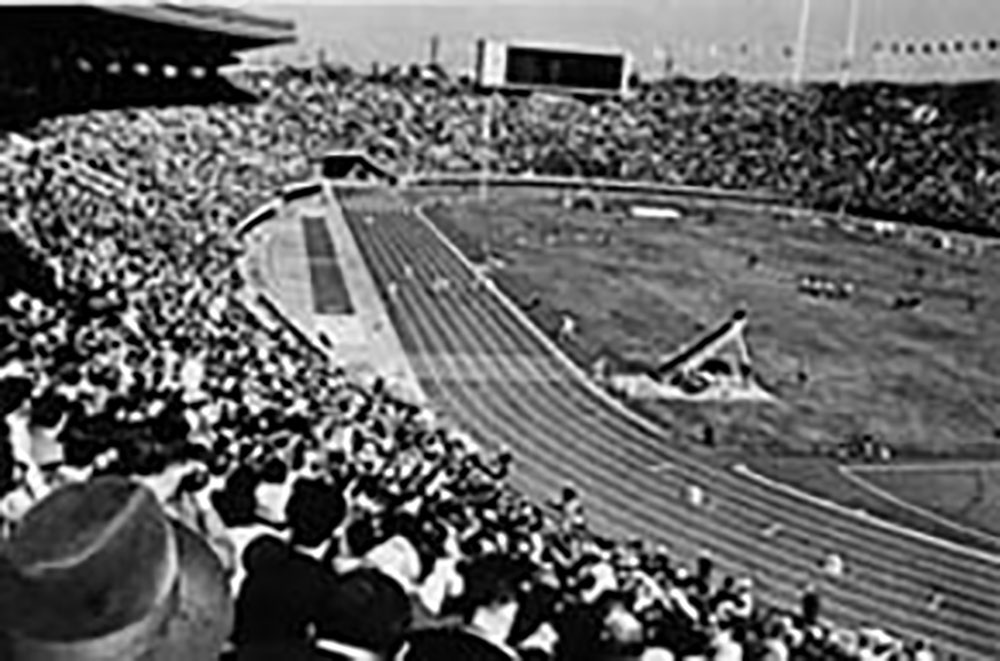
In October 10, 1964, four years after the Rome Olympics, the 18th Olympic Games at Tokyo were opened. Also in the Games, many photographers from home and abroad were to pit their skills against each other, though the number of photographers and the shooting points were severely limited and the shooting was only permitted from the specified stands for the opening and closing ceremonies and individual events and use of flash lamps was also prohibited except for the representative photographer called "pooler" of each country.
As a result, the cameras used were mostly combined with telephoto zoom lens, smaller f-number compact telephoto lens, or ultra telephoto lens. Among those, Nikon F and Nikkor lenses played a leading role. Then, appeared a strong weapon for the camera and lens combinations: the electric motor drives for continuous exposure which were first installed on the SLR cameras.
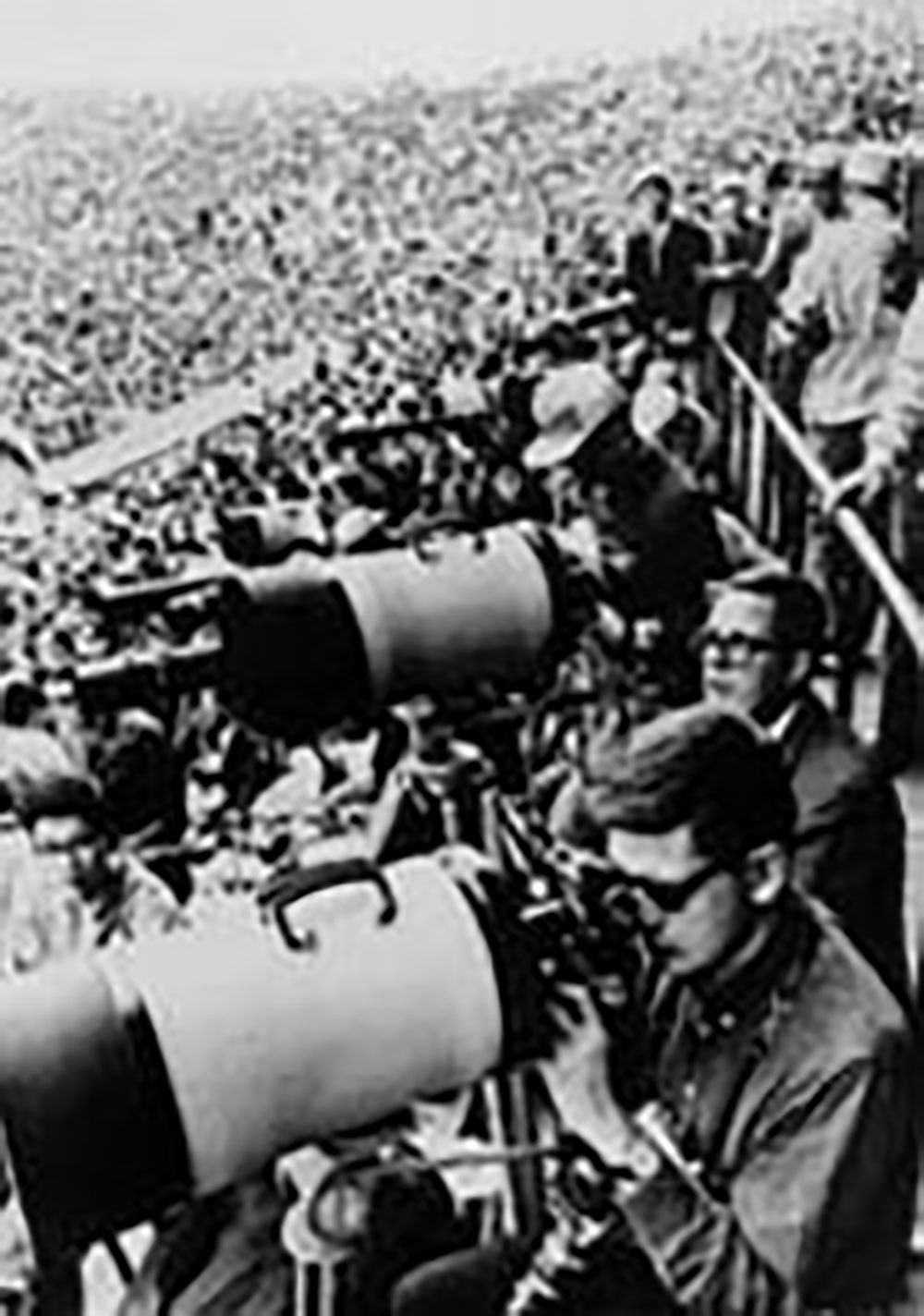
The Nikon SP and S3 with wide-angle lenses also worked fully as sub-cameras. The production of the rangefinder cameras was discontinued in April 1963 with a total production of a little more than 21,300, but at the strong request of news cameramen, we produced a limited number of SPs in May 1964 to meet that request.
Additionally in 1965, the year after the Tokyo Olympics, Nikon S3 Black (with 50 mm f/1.4) was also produced in a limited number of 2,000.
During the Tokyo Olympics, we set up a special service depot in the Nihon Seinenkan building at Sendagaya, Shibuya-ku adjacent to the National Athletic Stadium to help the news cameramen to work actively, and provided camera inspection and repair and other services by the end of October.
In the building, were set up a press center, a data summarization center and other central facilities for the press regarding the Olympics. The building was also used as the accommodations for the board of the Olympic Organizing Committee; therefore, utilization by the news cameramen from both home and abroad was sufficiently high and we achieved a brilliant success.
Increasing sales of SLR camera Nikomat and interchangeable lenses
Growing business performance
The recession in 1965 touched bottom in the autumn of 1965 and the economy started taking off again, leading to the five-year "Izanagi" boom.
Our sales averaged annual growth rates of 26.3% from FY 1965 to 1970 through stimulated domestic demand and increased exports, during which the sales exceeded the 10 billion yen mark in March 1959 (100th business term).
During that period, the camera division consistently took the initiative in bolstering profitability, and the domestic sales and exports both kept increasing owing to the robust sales of Nikon F series and also Nikomat series and Nikkor lens.
However, the boom started to decline in the autumn of 1969, and the depression started to hang over the country near the end of the Japan International Exposition EXPO '70 held at Senri, Osaka from March thru September 1970.
Despite the depression, the camera division showed successful growth in sales involving the high-end SLR cameras, and the glass division also made a good showing in the cutthroat competition in the industry, and the camera and glass divisions dealing with durable consumer goods made up for the dullness in the equipment and machinery divisions.
Contributions by Nikomat and interchangeable lenses
The camera industry formed a counter-recession cartel in June 1965 to improve the gap between supply capacity and actual demand, and to take measures to combat the recession such as increasing the exports, promoting the shift to high-end models, developing new models and improving the distribution network for promotion of demand. This was successful. In addition, owing to the special procurement boom caused by the Vietnam War in 1966, the exports grew. As a result, the economy recovered rapidly and then the counter-recession cartel was canceled in March 1966.
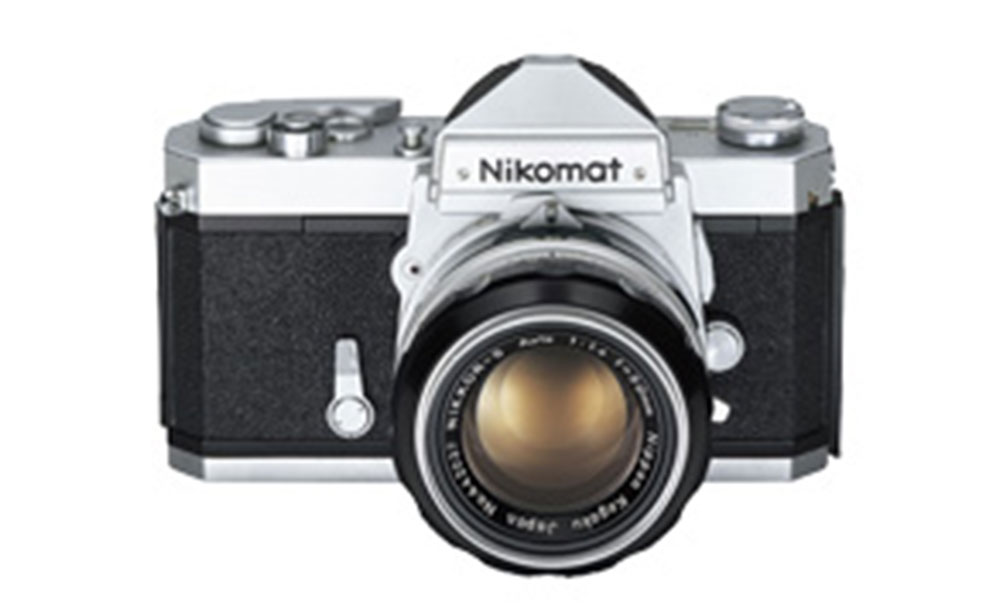
We counted on NIKKOREX F, NIKKOREX 35 series, Nikon AUTO35 and other mid-end and popular models of SLRs which we had introduced in the second half of 1960 to generate new demand but they did not sell as well as expected, although there was still a demand for high-end models.
The Nikomat FT went on sale in July 1965 and its introduction on the market created a sensation due to its ability to use most of the various interchangeable lenses and many accessories for the Nikon F system, its high performance and easy operation with the TTL exposure meter integrated in the compact body, and its reasonable price.
This camera was popular especially among young camera users, and sales volume exceeded 100,000 by March 1967 as the demand for Nippon Kogaku SLR cameras expanded and gained new strength.
In October 1967, Nikomat FTN was introduced, featuring a change in the metering system from measuring average light over the entire region to center-weighted measurement, and the total sales volume of the Nikomat series soared to 400,000 by March 1970.
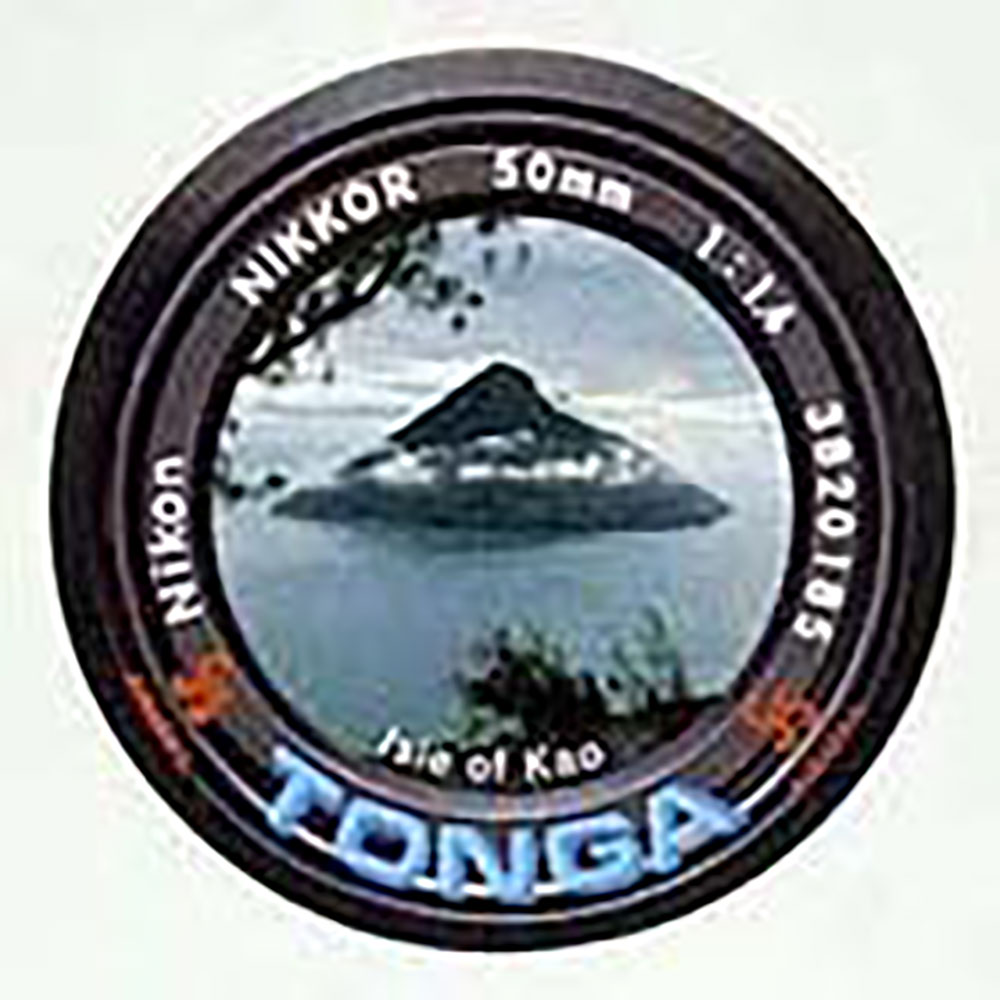
The popularity of the Nikon F and Nikomat series helped promote sales of interchangeable lenses. Due to the successive development of new lenses, the varieties of interchangeable lenses for F increased from year to year, and sales were also steadily increasing since the release of Nikomat with a surprising rise in sales volume to 340,000 units in FY 1970 from 60,000 in FY 1965.
During that period, the ratio of sales of interchangeable lens (standard lens not included) to camera body increased from 0.75 in FY 1966 - 1967 to 1.2 in FY 1971 - 1972, and even the additional increases in production were unable to catch up with the demand.
Then, in order to set up a system for increasing the output of standard and interchangeable lenses concurrently with an in increase in production of camera systems, Sakura Electronic Industries, Ltd, a subsidiary engaged in production in Ibaraki Prefecture, planned to expand its production facilities, and constructed a new lens assembly and adjustment plant in September 1970. Thereafter, the second and third expansion of facilities and equipment followed, and the company became a lens volume-production plant involving processing thru assembly and adjustment.
During the period of growing demand for SLR cameras from 1965 to 1975, the camera division increased its sales every business term by adding the rise in sales of Nikomat and interchangeable lenses to the persistent demand for Nikon F series, thereby acting as pulling power through the period for successful business showing of Nikon.
The total sales of the Nikomat series amounted to 1 million in FY 1973, and the total sales of Nikkor lenses for F exceeded 2.5 million in February 1972.
| 1963 | 1966 | 1969 | |
|---|---|---|---|
| Nikon F series | 41 | 58 | 101 |
| NIKKOREX F | 18 | 0 | - |
| Nikomat series | - | 69 | 133 |
| NIKKOREX 35II | 21 | - | - |
| NIKKOREX ZOOM35 | 8 | 0 | - |
| Nikon AUTO35 | (21) | 3 | - |
| Interchangeable lenses for F (standard lens not included) | 59 | 100 | 207 |
Note:
The values in parentheses refer to 1964 data.
Product and company names in this article are trademarks, registered trademarks, or products of their respective owners.
Colors of product photographs on the monitor may differ from the colors of the actual products.
Camera Chronicle
Archives of corporate history subject matter related to Nikon cameras, including rare materials, as well as product photos of cameras and lenses.

